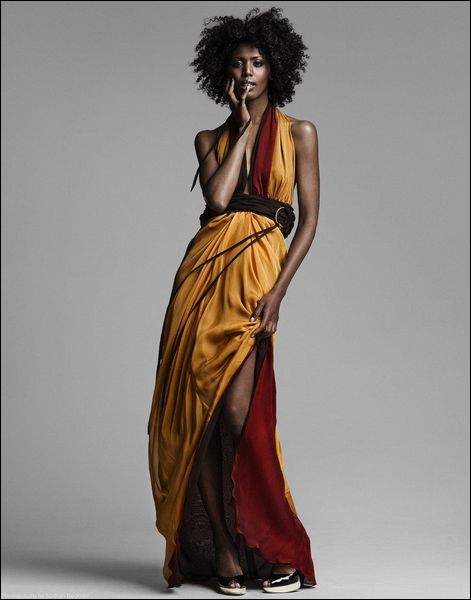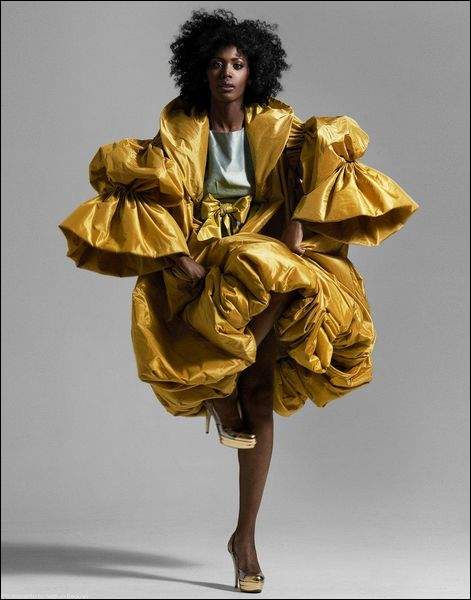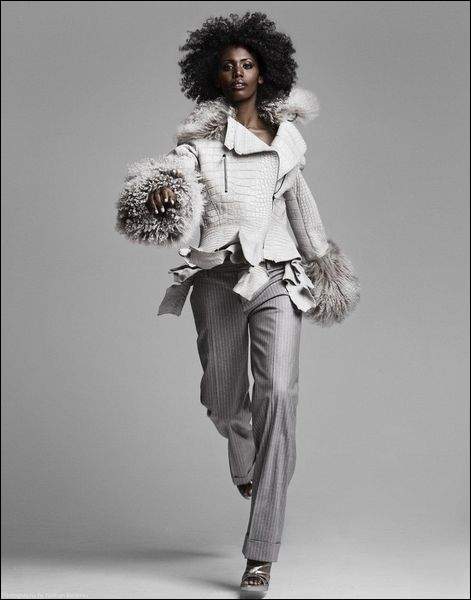It happened 46 years ago, but she still feels the thrill.
Shirley Jackson was 15, and she was going to the Ebony Fashion Fair.
She stayed up all night with a girlfriend sewing fabric for what she was sure would be a sophisticated dress for the most exciting fashion show she would attend.

(NATHAN BECKNER)
Jean Louis Scherrer silk chiffon column gown with tri-color bodice with brass loops and fabric streamers.
And then, at the Ford Auditorium in downtown Detroit, she saw them.
Beautiful black models wearing stunning designs from all over the world.
"For a 15-year-old," she says, "it was eye-popping."
But the Ebony Fashion Fair symbolizes more than just a show with some nice outfits.
It always has.
"It was a breakthrough," Jackson says. "I didn't realize that there were African-American models of that stature. It was another indication that we could do things. You didn't have to be a teacher or a secretary or a nurse, which were the predominant professions for black women who were college-trained."
Jackson, 61, a principal leadership coach, will preside over the 50th Anniversary of the Ebony Fashion Fair in Detroit as general chair with the Detroit Alumnae Chapter of Delta Sigma Theta Sorority Inc., which is hosting the show at the Max M. Fisher Music Center on Sunday.
In its 50 years, the Fashion Fair has raised more than $55 million for African-American organizations nationwide. Last year, the Detroit show raised more than $30,000 for scholarship and public service programs run by the Detroit chapter.
More than that, Fashion Fair has had a cultural impact that still resonates.

Gilles Montezin balloon sleeve, silk taffeta opera coat.
"When this event started, there was still a huge amount of segregation," says Alicia Nails, 50, of Southfield, the public relations chair of the Detroit chapter. "This was an event where we could arrive with dignity and sit where we wanted.
"In the 1950s, if you didn't go to Paris, where else would you see this stuff?"
What people will see at this year's Fashion Fair, "Glam Odyssey: A Fashion Journey into Bliss and Beyond," are 11 women and 2 men strutting the stage in some of the finest clothing around.
The Fair was bolstered over the decades by its producer and director, Eunice W. Johnson, who made hundreds of trips to Europe to purchase clothing from fashion houses for the nationally touring event.
Fashion Fair has produced American icons, like Richard Roundtree, a model who went on to star in "Shaft," and Pat Cleveland, who became a supermodel. This year's show will continue showing off designs from the world's biggest names, including Christian Dior, Dolce & Gabbana and Carolina Herrera.The legacy of Fashion Fair is not lost on Ontwanet Moran, 26, of Los Angeles, a model who will wear 16 of the 200 outfits in the show.
"It's just an honor to be a part of black history," she says. "It's a show that, for the black race, says 'You can't hold us down.'
"To know this was around before I was even born and all the things it's accomplished and all the scholarship money that it's raised, there are no other words that can describe being in it except by saying it's a blessing."
Moran, who is in her second year with the Fashion Fair, says the audience can expect more creativity and dancing from the models.
Jeena Quansah, a model from Washington, D.C., says, "It's more than walking down the runway looking like an android. You gotta move!"
The show celebrates diversity within the black community.
"We represent different shapes and sizes and hair types, from the lighter skin to darker skin woman," says Quansah, 26. "It's amazing for us to just come together and represent all types instead of focusing on maybe the lighter skin tones. It's all beautiful."
To Jada Collins, show commentator, learning about Fashion Fair and cutting-edge clothing through the pages of Ebony and JET magazines gave her a feeling she could find nowhere else.

(NATHAN BECKNER)
Emanuel Ungaro crocodile and Mongolian lamb jacket, pinstripe pants
Staci R. Collins Jackson, assistant vice president and director of corporate affairs at Johnson Publishing, which puts out Ebony and JET, says the show has lasted so long because people who grew up with it are so loyal that they take their children, too. At its core, says Collins Jackson, the 50th anniversary event is "really just a fashion journey. Anything that's hot is in this show."
Though it's impossible for her to attend every show on the tour, which hits 180 cities in the United States, Canada and the Caribbean, Collins Jackson will fly to the Detroit show to honor 82-year-old Detroiter Doris B. Arnold.
Arnold, a member of Delta Sigma Theta, sold 878 tickets to the show last year, the most of anyone in the country.
"This fashion show, to me, has always been what the concept cars are to the automobile industry," Arnold says. "It just has to be magnificent, magnificent, magnificent."













